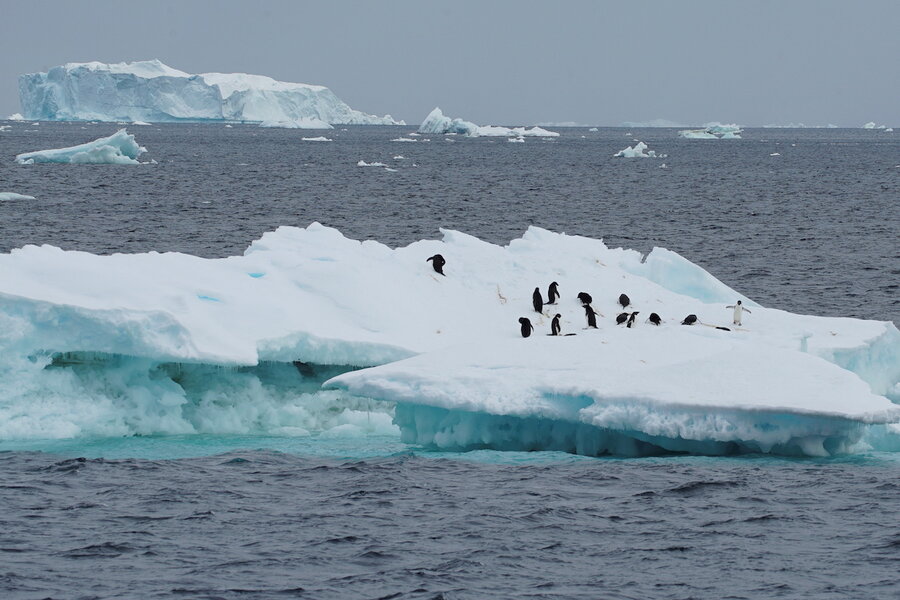Count of the penguins: Scientists get climate clues in Antarctica
| Aboard the MV Arctic Sunrise, Antarctica
Peering through binoculars from an inflatable motorboat bobbing in frigid waters, polar ecology researchers Michael Wethington and Alex Borowicz scan a rocky outcrop on Antarctica’s Andersson Island for splatterings of red-brown guano that might signal a colony of penguins nearby.
The birds have become far more than an iconic symbol of the earth’s frozen south. Scientists now use them as key indicators for understanding climate change near the South Pole – with certain western regions like the Antarctic Peninsula having undergone rapid warming, while East Antarctica remains cold and capped in ice.
“We are counting penguin nests to understand how many penguins are in a colony, producing chicks every year, and whether that number is going up or down with the environmental conditions,” said Mr. Borowicz, of Stony Brook University in New York.
For climate researchers, nothing is easy in the remote and icy reaches of Antarctica. But penguins are easier to track than other species because they nest on land and their black feathers and their waste can be spotted against the white expanse.
“We can use penguins as a bioindicator to see how the rest of the ecosystem is operating,” said Mr. Wethington, also of Stony Brook.
Simple counts of individual penguins alongside other methods like analysis of satellite images tell a nuanced story, with some penguins dubbed ‘winners’ as climate change opens new habitats, while others are forced to seek colder climes.
Wave of ‘gentoofication’
Gentoo penguins, with bright red-orange beaks and distinctive white markings on their heads, are partial to open water without chunks of ice bobbing around.
When temperatures on the Antarctic Peninsula began rising faster than almost anywhere else in the world during the latter half of the 20th century, gentoo populations expanded southwards in what some scientists call the “gentoofication” of Antarctica.
“Gentoo penguins don’t like sea ice,” said David Ainley, a biologist with the ecological consulting firm H.T. Harvey & Associates who has been studying penguins for more than 50 years. “They mostly forage over the continental shelf and don’t go far out to sea.”
As sea ice has decreased along the western side of the peninsula, gentoos have taken advantage of the hospitable conditions. But the same conditions have been worse for tuxedo-wearing Adélies, who rely on sea ice for breeding and feeding.
“When we find Adélie penguins, we typically know that sea ice is nearby,” Mr. Wethington said. “And whenever we’ve seen sea ice declining or disappearing altogether, then we’re seeing corresponding Adélie penguin populations decline substantially.”
Though widespread Adélie penguins are increasing in number overall, some populations have fallen by more than 65%.
‘Safe space’
On their January expedition to the region, the Stony Brook scientists found that Adélie colonies around the still-icy Weddell Sea had remained stable during the past decade.
“This peninsula is maybe a safe space as we see climate change progressing and overall warming throughout the globe,” Mr. Wethington said.
Heather Lynch, an ecologist at Stony Brook University who helped lead the expedition aboard the MV Arctic Sunrise, said the findings highlighted the region’s conservation value.
In 2020, a team from the British Antarctic Survey discovered 11 new emperor penguin colonies from satellite images, boosting known emperor penguin colonies by 20 percent.
But since 2016 nearly every chick has perished in the Halley Bay colony along the far eastern side of the Weddell Sea, which has long been home to the world’s second-largest emperor penguin colony, with some 25,000 breeding pairs gathering every year.
Scientists suspect the 2016 El Niño event changed the sea ice dynamic in the area, and worry for the penguins as climate change increases the frequency and severity of El Niño events.
While the chicks’ deaths were not a direct result of climate change, “there is a climate change aspect to the loss,” said Peter Fretwell, a geographic information scientist at the British Antarctic Survey.
This story was reported by Reuters.






